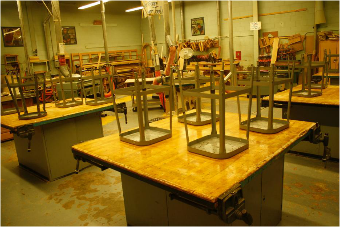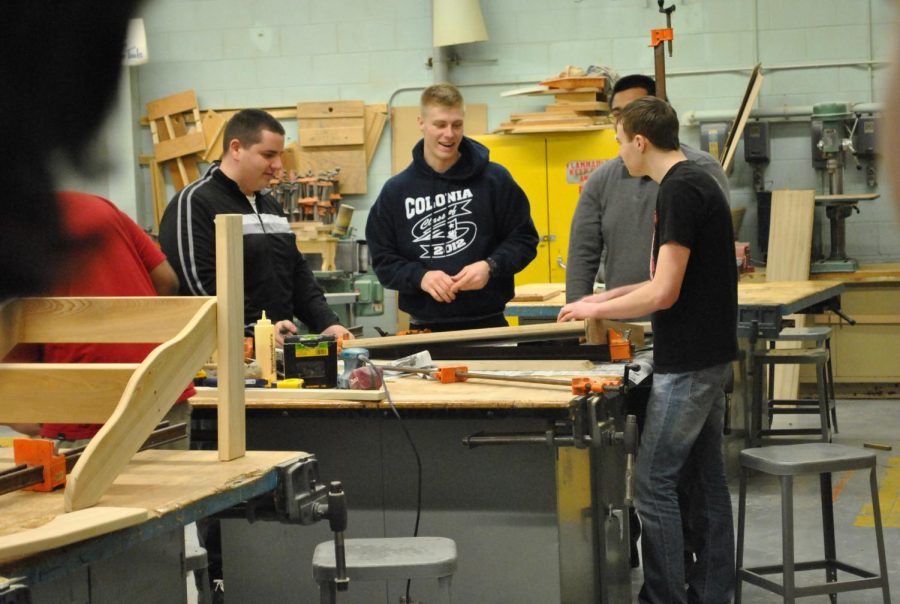High schools mainly teach kids to pass their classes sit down and listen and get good grades for college. If you are a kid, like me, who is not the best in a traditional classroom and doesn’t want to go to college, what do you do? Schools should be setting up all students for success in any field. Unless you are on track to go to college, there is not one class offered at the high school level that can prepare non-academic student for their future. The designs of school curriculums and standardized tests in our country prepare students for four-year colleges — not skilled trades.
There is a huge need to bring back trades to teach students life skills and to see if they might want to turn it into their careers. These classes were also beneficial to students not looking to make a career out of it. At some point, most students will become homeowners and vehicle owners. Students should know how to change their own oil, do basic home repairs or sew a button. Schools need to stop telling and making students feel like college or the military are their only options.
Pros of going into a trade
With some certificates, students can start making a salary earlier than someone trying to earn a four- year college degree. According to Indeed the following trade careers have these average salaries in the United States:
- Dental Hygienist – $41.13 per hour
- HVAC – $23.27 per hour
- Plumbers – $22.84 per hour
- Electrician – $26.91 per hour
- Landscape designer – $57,367 per year
- Construction Manager – $76,164 per year
- Beautician -$25,620 per year

Also, with 2-4 years of experience in many of these jobs the average salary increases. On the plus side, these workers are in high demand so finding a job in a trade should be easy.
Another advantage of going into the trades is happiness at work. “Skilled tradespeople report greater fulfillment levels than other careers, with 83% of them feeling a high level of job satisfaction,” according to Shamrck.
Why are there less trade workers
For starters, Home Economics certificates or Family & Consumer Sciences teaching certificates are hard to come by in some states. Professionals in the field are also not allowed to teach a high school course without a four-year teaching degree and certification. The Comprehensive Family & Consumer Science teaching certificate in New Jersey requires a GPA of 3.0 or higher and applicants must also pass the Praxis. Their course load in college must include a minimum of 30 credits in:
- Child and family development/care or human development
- Food preparation, nutrition or food science
- Apparel design/construction or textiles
- Interior design or housing and environments
- Personal/family finances or resource management
However, finding a college that offers that major may be as much of a challenge as finding a trade worker willing to get a bachelor’s degree just to teach.
The other factor is that when budgets are cut, these classes and teachers are the first to go as noted in a Fox Business article in 2022. With schools pushing S.T.E.M. classes and advance courses, some states and districts feel home economics courses and skills aren’t needed. At Colonia High School, when Mr. Bill Leahy, long-time woodshop teacher, retired in 2018 the school, not the district, stopped offering woodshop and home improvement classes
Ms. Jacqueline Giordano, Student Assistance Counselor at Colonia High, explained that students looking to go to vocational school for a trade in New Jersey would have to make that decision in eighth grade so they can enroll full time to a vocational school. Colonia students, who previously enrolled part-time at vocational school struggled to complete the required number of hours in their field of study. Many of them attended classes in the evening to complete the requirements. Not many students are willing to do that these days.
More recently, the pandemic caused a major disruption in America’s labor force — referred to as “The Great Resignation.” It has also been termed Great Reshuffle, Great Attrition or Big Quit. In 2021, more than 47 million workers left or had to leave their jobs. Many were in search of an improved work-life balance and flexibility, increased compensation and a strong company culture. EdSmart reported that in 2022 the top industry experiencing the most resignations was trade, transportation and utilities with 2,052,000 people leaving the field.

Future problems
Trades are very important because they help with fueling economic growth, supporting good jobs at home and raising living standards.
In November of 2021, U.S. President Joe Biden passed the $1.2 trillion Infrastructure Investment and Jobs Act but the United States does not have enough skilled trade workers to actually improve the infrastructure. As a part of that bill, the Jobs Acts looks to change the stigma around dirty jobs or trade jobs.
By the fourth quarter of 2025, Moody’s Analytics projects there will be” 872,000 more jobs with about 461,000 are expected to be in construction; 227,000 in manufacturing; 75,000 in transportation and distribution” because of the law. According to CNN, “Labor experts and training advocates say even that amount might not be enough.” It is also predicted that the salaries for these skilled labor jobs will increase as well.
“But there’s a big kink in this grand plan, labor experts and economists say: There’s simply not enough money to educate and develop the hearty stream of skilled workers needed for all those critical roles,” WSILTV stated. The article went on to say, “It would still leave the US lagging far behind other industrialized nations in labor skills spending.”
Bringing back the trades to high schools might help the situation and get a younger generation into these fields quicker.













